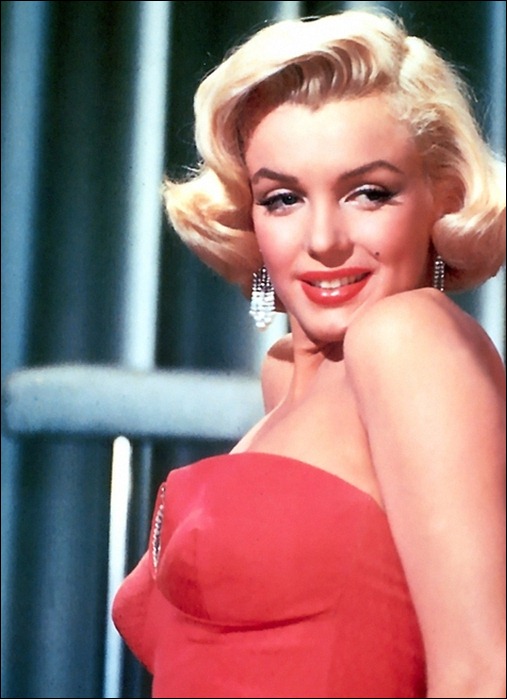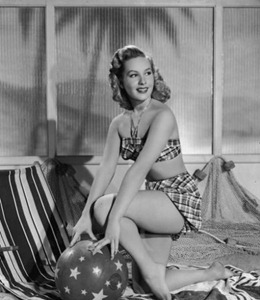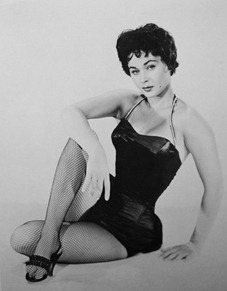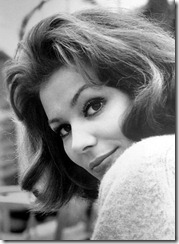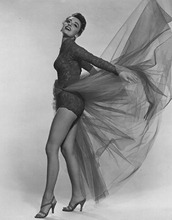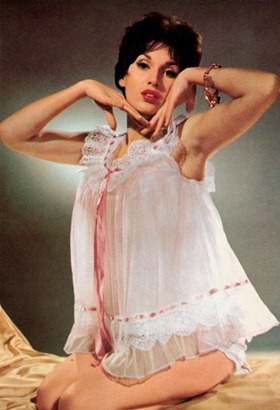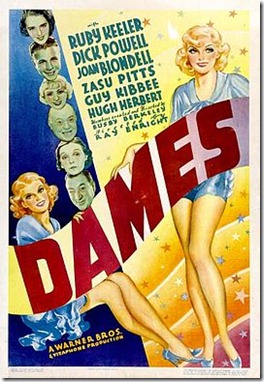A recreation of an article by Roger Turrell in Adam Vol 4 No 4 1960


WENDY MARCH regarded her interviewer solemnly through smoky, grey-blue eyes and said, "As a matter of fact, I think my back side is a lot more photogenic than my front. Which is a hell of a note for a girl who wants to be a serious dramatic actress, if you ask me!"
No one had asked her this some what startling bit of information was wholly volunteered – but a quick, if intensive study of what sat facing you across the table resulted in firm conviction that there was nothing especially wrong with what was up front either. In fact, it very definitely counted."What I mean," said Wendy, "is that my thirty-five chest is hardly big league against what most of the girls who do pinups put on display. On the other hand, my backside is – well, real curvy.
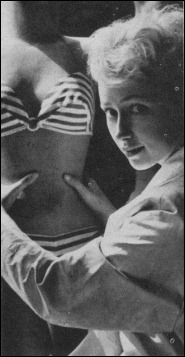


She could say that again as far as you were concerned. But you let her keep it parked on a wood-and-canvas chair on the terrace of a super espresso joint on Hollywood’s Sun set Strip called Cyrano’s. Instead, you study the pale, serious little face that looks back at you. It’s pretty, a little on the girlish side, reminiscent of Jane Powell or the Joan Blondell of some seasons back. The blue-grey eyes are wide and well lashed, the nose pert and a trifle flattened across the bridge, the mouth fluid and expressive.
All in all, it’s rather a sad little face, clothed in what is probably the creamiest white complexion in Hollywood or anywhere else – so waifish that you wonder if it wasn’t born for comedy. After all, Mabel Norman, the first great comedienne of the silent films, had that same quality of sadness underlying her vivacity. As did Chaplin and Kea ton and the rest."No comedy," says Wendy firmly, raising a forkful of green salad to emphasize the point like a flag of Erin. "My goal is to be a fine dramatic actress. My hero – or rather, heroine – is Bette Davis. That’s the kind of an actress I intend to be."

Big words, bravely spoken by a little girl just 21, who graduated from the University of Southern Illinois only last June. But there is a dedicated ferocity in her speech about such matters that indicates the hot fires of ambition ablaze in her delicate 114-pound little body. She means business."Look," she says, "I’ve only been out here four months, and in that time I’ve picked up one screen credit for ‘The Private Lives of Adam and Eve’ at Universal-International, and a TV credit in ‘Lawman’ at Warners."
Who’s Wendy’s agent? "I don’t have one yet," she replies. ‘So far, I’ve got what I’ve gotten by batting my head against every producer’s wall I could find. I want to pick up a few more credits on my own be fore I go after an agent. Then may be I’ll rate some attention from a good one, instead of just being a no body."It makes sense. You let her tell you about herself, of how she was born in Youngstown, Ohio, where her father was superintending a steel company construction job, work that led him and his little family to Texas for 10 years and other wise just about all over the map.


"When I was three days old," she says, "I cracked the medical history books. I was the first girl baby on record to get pyloric stenosis. That’s a closing of the passage be tween the stomach and intestines. I would have died of malnutrition if they hadn’t fixed it up." Other moppet achievements include Wendy’s climbing into a toilet seat to brush her teeth – she wasn’t tall enough to reach the basin – and falling into a Texas cesspool while trailing an 11-year-old boy across a back lot.
For this, her revenge was as spectacular as it was messy. "I waited till I knew he was taking a bath, then crashed the bathroom and poured a whole box of bath-powder over him. He was a worse mess when he got out than I was when I climbed out of that cesspool even if he smelled sweeter." Didn’t we mention that Wendy is a determined wench? She comes by it naturally enough, being a direct descendant of Henry Wadsworth Longfellow, the poet, on her, mother’s side, and of Declaration of Independence Signer John Hancock of her father’s. Neither of these famed New Englanders was noted for being exactly wishy-washy.

Wendy began taking dancing lessons – tap, toe and ballet – at the tender age of seven, under the parental impetus of her mother. "No, mother has no frustrated theatrical ambitions of her own," the girl says. "She just wanted me to take dancing lessons the way a father wants to teach his son athletics. I’m still dancing. I don’t suppose I’ll stop until I’m seventy." At the age of eight, she was proficient enough to take part in school recitals, and disaster struck out in front of everybody when one of her dancing shoes fell off. But Wendy, even at that age, was far from fazed. "Our teacher had kept telling us, ‘No matter what-keep going!’ So I simply kept going and wished I were dancing on the side of a hill instead of a level stage."
 Another momentous misoccasion was Wendy’s graduation from gram mar school. On this occasion, wearing a long, solemn white dress for the occasion, she managed to fall upstairs when summoned to the platform to receive her certificate. In general, however, she is much, much too intelligent to get into. the sort of jams that make for exciting copy. Her IQ. is up around the genius level, although she scoffed at such indices of high intelligence. "I was just lucky enough to get good schooling," she demurs.
Another momentous misoccasion was Wendy’s graduation from gram mar school. On this occasion, wearing a long, solemn white dress for the occasion, she managed to fall upstairs when summoned to the platform to receive her certificate. In general, however, she is much, much too intelligent to get into. the sort of jams that make for exciting copy. Her IQ. is up around the genius level, although she scoffed at such indices of high intelligence. "I was just lucky enough to get good schooling," she demurs.
Wendy has been deeply in love twice. "But," she says, "each time marriage loomed in the offing, I got cold feet and pulled out. I can’t see sacrificing the career I’m after for a washing machine and a mess of diapers." As for men – "I adore them! But only if they’re men! I think you know what I mean. No female impersonators in my life if I can help .
Wendy also adores dogs and has had two cocker spaniels, both of them named "Jigger". She reads a good bit, mostly psychology and scientific studies of hypnotism at present. She is a fine ballroom as well as a performing dancer, and has even taught it to earn extra pin money at college. She keeps a diary and has a novel in writing ("It’s about me, and I haven’t got an ending yet."), also collects stuffed animals and carved ivory elephants bull elephants please take note. But acting is Wendy’s main line. "I’m like an alcoholic," she confesses. "I only come alive when I’m giving a performance."
Oddly, she did little acting in college theatricals, preferring to work backstage and, in her own words, "really learn the business from the ground up." Outside of that, Wendy had done just little theater work be fore coming to Hollywood. So how did she happen to take the plunge? "Well, I was with Dad in New York last Christmas – he and mother are divorced, though I adore both of them – and he asked me if I’d like a mink stole for my stocking. All of a sudden – just like that! I knew I didn’t want a mink stole half as much as I wanted to come out here. So I told Dad I wanted a ticket to Hollywood instead." "He laughed and said, "Okay, honey, I’ll get you a round-trip ticket.’ "I told him, ‘Make it one-way.I’m not coming back.’ "
So, in due course, Wendy arrived in Hollywood with her mother and took a small apartment in Hollywood and began making the rounds of the casting directors. So far, she’s been doing okay for a cold-nosed beginner, and she should be doing a whole lot better soon. This girl has the sort of determination that just can’t be stopped for long, and she is cute as the proverbial gnat’s ear and smart as the equally proverbial whippet to boot. It’s a safe bet she won’t be regret ting that no-return-trip ticket for a long, long time, if ever.
Read Full Post »
 Lili Kardell was born in Stockholm, Sweden. Her father, Thore Kardell, was a Swedish orchestra leader. At 17 she is on the Stockholm stage and a year later she goes to the States and is put under contract with Universal-International. In 1955 she meets James Dean at a Palm Springs party and zips around with him in his new white Porsche. September 30 is the saddest day in her life when Dean is killed, when his sports car crashes. She claims they were like brother and sister.
Lili Kardell was born in Stockholm, Sweden. Her father, Thore Kardell, was a Swedish orchestra leader. At 17 she is on the Stockholm stage and a year later she goes to the States and is put under contract with Universal-International. In 1955 she meets James Dean at a Palm Springs party and zips around with him in his new white Porsche. September 30 is the saddest day in her life when Dean is killed, when his sports car crashes. She claims they were like brother and sister. 











